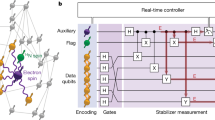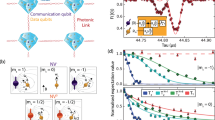Abstract
Quantum registers of nuclear spins coupled to electron spins of individual solid-state defects are a promising platform for quantum information processing1,2,3,4,5,6,7,8,9,10,11,12,13. Pioneering experiments selected defects with favourably located nuclear spins with particularly strong hyperfine couplings4,5,6,7,8,9,10. To progress towards large-scale applications, larger and deterministically available nuclear registers are highly desirable. Here, we realize universal control over multi-qubit spin registers by harnessing abundant weakly coupled nuclear spins. We use the electron spin of a nitrogen–vacancy centre in diamond to selectively initialize, control and read out carbon-13 spins in the surrounding spin bath and construct high-fidelity single- and two-qubit gates. We exploit these new capabilities to implement a three-qubit quantum-error-correction protocol14,15,16,17 and demonstrate the robustness of the encoded state against applied errors. These results transform weakly coupled nuclear spins from a source of decoherence into a reliable resource, paving the way towards extended quantum networks and surface-code quantum computing based on multi-qubit nodes11,18,19.
This is a preview of subscription content, access via your institution
Access options
Subscribe to this journal
Receive 12 print issues and online access
$259.00 per year
only $21.58 per issue
Buy this article
- Purchase on Springer Link
- Instant access to full article PDF
Prices may be subject to local taxes which are calculated during checkout




Similar content being viewed by others
Change history
07 February 2014
In the version of this Letter originally published online, in Fig. 3b in one instance of RXπ/2, a subscript 'α' was used instead of a subscript 'X'. This error has now been corrected in all versions of the Letter.
References
Awschalom, D. D., Bassett, L. C., Dzurak, A. S., Hu, E. L. & Petta, J. R. Quantum spintronics: engineering and manipulating atom-like spins in semiconductors. Science 339, 1174–1179 (2013).
Koehl, W. F., Buckley, B. B., Heremans, F. J., Calusine, G. & Awschalom, D. D. Room temperature coherent control of defect spin qubits in silicon carbide. Nature 479, 84–87 (2011).
Yin, C. et al. Optical addressing of an individual erbium ion in silicon. Nature 497, 91–94 (2013).
Gurudev Dutt, M. V. et al. Quantum register based on individual electronic and nuclear spin qubits in diamond. Science 316, 1312–1316 (2007).
Neumann, P. et al. Multipartite entanglement among single spins in diamond. Science 320, 1326–1329 (2008).
Fuchs, G. D., Burkard, G., Klimov, P. V. & Awschalom, D. D. A quantum memory intrinsic to single nitrogen–vacancy centres in diamond. Nature Phys. 7, 789–793 (2011).
Van der Sar, T. et al. Decoherence-protected quantum gates for a hybrid solid-state spin register. Nature 484, 82–86 (2012).
Maurer, P. C. et al. Room-temperature quantum bit memory exceeding one second. Science 336, 1283–1286 (2012).
Pfaff, W. et al. Demonstration of entanglement-by-measurement of solid-state qubits. Nature Phys. 9, 29–33 (2013).
Pla, J. J. et al. High-fidelity readout and control of a nuclear spin qubit in silicon. Nature 496, 334–338 (2013).
Dolde, F. et al. Room-temperature entanglement between single defect spins in diamond. Nature Phys. 9, 139–143 (2013).
Jiang, L. et al. Repetitive readout of a single electronic spin via quantum logic with nuclear spin ancillae. Science 326, 267–272 (2009).
Lee, S-Y. et al. Readout and control of a single nuclear spin with a metastable electron spin ancilla. Nature Nanotech. 8, 487–492 (2013).
Cory, D. G. et al. Experimental quantum error correction. Phys. Rev. Lett. 81, 2152–2155 (1998).
Moussa, O., Baugh, J., Ryan, C. A. & Laflamme, R. Demonstration of sufficient control for two rounds of quantum error correction in a solid state ensemble quantum information processor. Phys. Rev. Lett. 107, 160501 (2011).
Schindler, P. et al. Experimental repetitive quantum error correction. Science 332, 1059–1061 (2011).
Reed, M. D. et al. Realization of three-qubit quantum error correction with superconducting circuits. Nature 482, 382–385 (2012).
Bernien, H. et al. Heralded entanglement between solid-state qubits separated by three metres. Nature 497, 86–90 (2013).
Nickerson, N. H., Li, Y. & Benjamin, S. C. Topological quantum computing with a very noisy network and local error rates approaching one percent. Nature Commun. 4, 1756 (2013).
Neumann, P. et al. Single-shot readout of a single nuclear spin. Science 329, 542–544 (2010).
Robledo, L. et al. High-fidelity projective read-out of a solid-state spin quantum register. Nature 477, 574–578 (2011).
Dreau, A., Spinicelli, P., Maze, J. R., Roch, J. F. & Jacques, V. Single-shot readout of multiple nuclear spin qubits in diamond under ambient conditions. Phys. Rev. Lett. 110, 060502 (2013).
Taminiau, T. H. et al. Detection and control of individual nuclear spins using a weakly coupled electron spin. Phys. Rev. Lett. 109, 137602 (2012).
Kolkowitz, S., Unterreithmeier, Q. P., Bennett, S. D. & Lukin, M. D. Sensing distant nuclear spins with a single electron spin. Phys. Rev. Lett. 109, 137601 (2012).
Zhao, N. et al. Sensing single remote nuclear spins. Nature Nanotech. 7, 657–662 (2012).
Hodges, J. S., Yang, J. C., Ramanathan, C. & Cory, D. G. Universal control of nuclear spins via anisotropic hyperfine interactions. Phys. Rev. A 78, 010303 (2008).
Zhang, Y., Ryan, C. A., Laflamme, R. & Baugh, J. Coherent control of two nuclear spins using the anisotropic hyperfine interaction. Phys. Rev. Lett. 107, 170503 (2011).
Maze, J. R., Taylor, J. M. & Lukin, M. D. Electron spin decoherence of single nitrogen–vacancy defects in diamond. Phys. Rev. B 78, 094303 (2008).
London, P. et al. Detecting and polarizing nuclear spins with double resonance on a single electron spin. Phys. Rev. Lett. 111, 067601 (2013).
Filidou, V. et al. Ultrafast entangling gates between nuclear spins using photoexcited triplet states. Nature Phys. 8, 596–600 (2012).
Bar-Gill, N., Pham, L. M., Jarmola, A., Budker, D. & Walsworth, R. L. Solid-state electronic spin coherence time approaching one second. Nature Commun. 4, 1743 (2013).
Waldherr, G. et al. Quantum error correction in a solid-state hybrid spin register. Preprint at http://arxiv.org/abs/1309.6424 (2013).
Acknowledgements
The authors thank L. Childress, J.J.L. Morton, O. Moussa and L.M.K. Vandersypen for discussions and comments. T.H.T. acknowledges support from a Marie Curie Intra European Fellowship within the 7th European Community Framework Programme. Work at the Ames Laboratory was supported by the US Department of Energy Basic Energy Sciences (contract no. DE- AC02-07CH11358). The authors acknowledge support from the Dutch Organization for Fundamental Research on Matter (FOM), the Netherlands Organization for Scientific Research (NWO), the DARPA QuASAR programme, the EU SOLID and DIAMANT programmes, and the European Research Council through a Starting Grant.
Author information
Authors and Affiliations
Contributions
V.V.D., T.H.T., T.v.d.S. and R.H. conceived the control method. T.H.T., J.C., T.v.d.S. and R.H. devised the experiments. T.H.T., J.C. and T.v.d.S. performed the measurements and processed the data. T.H.T. and R.H. wrote the manuscript. All authors analysed the results and commented on the manuscript.
Corresponding author
Ethics declarations
Competing interests
The authors declare no competing financial interests.
Supplementary information
Supplementary information
Supplementary Information (PDF 1530 kb)
Rights and permissions
About this article
Cite this article
Taminiau, T., Cramer, J., van der Sar, T. et al. Universal control and error correction in multi-qubit spin registers in diamond. Nature Nanotech 9, 171–176 (2014). https://doi.org/10.1038/nnano.2014.2
Received:
Accepted:
Published:
Issue Date:
DOI: https://doi.org/10.1038/nnano.2014.2
This article is cited by
-
Coupling-selective quantum optimal control in weak-coupling NV-\(^{13}\)C system
AAPPS Bulletin (2023)
-
Noisy intermediate-scale quantum computers
Frontiers of Physics (2023)
-
Nuclear spin-wave quantum register for a solid-state qubit
Nature (2022)
-
Fault-tolerant operation of a logical qubit in a diamond quantum processor
Nature (2022)
-
Robust quantum-network memory based on spin qubits in isotopically engineered diamond
npj Quantum Information (2022)



